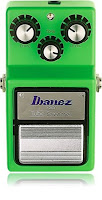
Ibanez Tube Screamers History
An Ibanez Tube Screamer is an overdrive/distortion pedal that is mild compared to many, but allows the true sound of the guitar and player's technique to come through. The most popular use of a tube screamer is to push a tube amp to make it overdrive more, but they sound good through almost anything.
If you are a geek like we are, check out this awesome article Tube Screamer®’s Secret for some cool info about why the tube screamer circuit sounds so good.
If you are a geek like we are, check out this awesome article Tube Screamer®’s Secret for some cool info about why the tube screamer circuit sounds so good.
TS-808 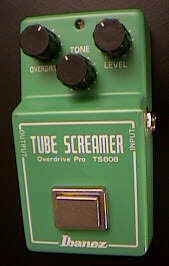
The first Tube Screamer was the green TS-808 overdrive pro in the late '70s. It was preceded by the Orange "Overdrive" and green "Overdrive-II" which came in narrower boxes without the battery cover, and the reddish "Overdrive-II" which had a box very similar to the TS-808. The lighter green OD-855 Overdrive-II is also in the TS-808 style box and has a circuit which is similar to the 808 - the board part numbers only differ by one digit. The overdrive and OD-II had a different, much more distorted, fuzzy circuit. The TS-808 and its generation have small square chrome on/off touch-buttons. Almost all TS-808's sound great. There were some TS-808s made in the 1979 period, mostly for other than USA markets, that came in a narrower box. These have a bottom plate that unscrews to change the battery like an MXR pedal, no plastic battery cover. This narrow TS-808 had a different circuit with more distortion. It uses two 1458 chips which are the 1st version of the low-tech dual op-amp. Also the LEVEL knob on these is labeled BALANCE and the external 9V power jack is next to the input jack. It used the same case as the earlier OVERDRIVE and OVERDRIVE-II pedals which used stomp switches. Ibanez probably had many left over and remade them as "TS-808" pedals to sell off the remaining cases.
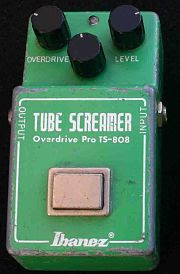
Early TS-808's have the Ibanez (R) "trademark" logo which some people seek. There is really no difference, although some of these have a Malaysian Texas Instruments RC4558P chip instead of the normal Japanese JRC4558 chip. I can use this chip in the mod if you would like, or can send both the JRC4558D and the RC4558P chips. A rare chip used was the TL4558P chip, as used in the early Boss OD-1 pedals. This is also Jim Weider's favorite chip in the King Of Tone pedal. Some of the early TS-808s also have a nut holding the power adaptor jack on, while later ones have no nut and a flush adaptor jack. It is not unusual for a TS-808 to have an undercoat of a different color (which can be seen in the ever-present corner chips).

The first Tube Screamer was the green TS-808 overdrive pro in the late '70s. It was preceded by the Orange "Overdrive" and green "Overdrive-II" which came in narrower boxes without the battery cover, and the reddish "Overdrive-II" which had a box very similar to the TS-808. The lighter green OD-855 Overdrive-II is also in the TS-808 style box and has a circuit which is similar to the 808 - the board part numbers only differ by one digit. The overdrive and OD-II had a different, much more distorted, fuzzy circuit. The TS-808 and its generation have small square chrome on/off touch-buttons. Almost all TS-808's sound great. There were some TS-808s made in the 1979 period, mostly for other than USA markets, that came in a narrower box. These have a bottom plate that unscrews to change the battery like an MXR pedal, no plastic battery cover. This narrow TS-808 had a different circuit with more distortion. It uses two 1458 chips which are the 1st version of the low-tech dual op-amp. Also the LEVEL knob on these is labeled BALANCE and the external 9V power jack is next to the input jack. It used the same case as the earlier OVERDRIVE and OVERDRIVE-II pedals which used stomp switches. Ibanez probably had many left over and remade them as "TS-808" pedals to sell off the remaining cases.

Early TS-808's have the Ibanez (R) "trademark" logo which some people seek. There is really no difference, although some of these have a Malaysian Texas Instruments RC4558P chip instead of the normal Japanese JRC4558 chip. I can use this chip in the mod if you would like, or can send both the JRC4558D and the RC4558P chips. A rare chip used was the TL4558P chip, as used in the early Boss OD-1 pedals. This is also Jim Weider's favorite chip in the King Of Tone pedal. Some of the early TS-808s also have a nut holding the power adaptor jack on, while later ones have no nut and a flush adaptor jack. It is not unusual for a TS-808 to have an undercoat of a different color (which can be seen in the ever-present corner chips).
Tube Screamer Family
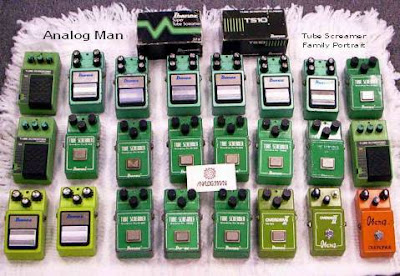
Here are some Ibanez pedals. The TS808s are seen in the middle. You can see one of the Narrow Euro TS-808 pedals, it's the leftmost of the TS-808s. The top row center 4 knob pedals are the ST9 Super Tube Screamers. At the top left are a pair of TS-10 pedals. The bottom left are SD9 Sonic Distortions. The bottom right is the original orange Ibanez Overdrive, with the slightly later OVERDRIVE-II on it's left, with the last version OVERDRIVE-II one more to the left.
Original TS-808 data
The following list are some of the serial numbers and features of TS-808 pedals. (R) means the trademark after Ibanez on the top of the pedal.
As you can see, the JRC chip was used throughout the life of the TS-808. There was even another 4558 chip, the TL4558P, used sometimes. In AB tests, there is VERY little difference between the three chips, although the JRC gives the strongest CLASSIC tube screamer sound- the sweet vocal midrange. The Malaysian RC4558P chip was probably used to save some money as they were cheaper than a Japanese made JRC chip. We would be glad to use the RC chip in your mod if you would like. They have a little bit more grit which some people might like.
SRV used the TS-808 for his trademark juicy strat tone. When he used smaller Fender amps that had natural overdrive, he used the TS set clean (low drive setting) with the level up high to push the amp for more distortion (see my CLEAN BOOST info below). When he played through big clean amps he turned the drive up more, about 1/2 way, with tone on about 3 and level about 7 to get the distortion from the TS.
TS9
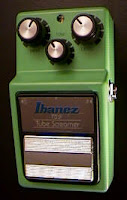
Around 1982 until 1985 the Ibanez pedals were repackaged and the 9-series of effects were made. The most popular is the TS-9 tube screamer, which is almost the same as the TS-808 internally. Externally the on/off switch grew to fill about 1/3 of the effect. The main change in the TS-9 circuit is in the output section. This caused the tube screamer to be a bit brighter and less "smooth". The Edge from U2 uses a TS9 for most of his overdrive tones, as do countless other famous rock and blues players. In later years the TS-9s were put together with seemingly random op-amp chips, instead of the JRC-4558 which is called for in the schematics. Some of these sound BAD, especially the JRC 2043DD chips. If you have an original TS9 with the 2043 chip, our 808 mods will make a huge difference in tone.
STL and TS10
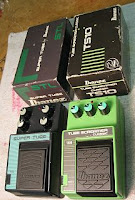
After the 9 series was discontinued, the MASTER or L series pedals were made, without a tube screamer in the lineup. This series was only made in about 1985. They did include the SUPER TUBE model STL, which is like a 4 knob tube screamer. It is similar to the rare and valuable ST-9 Super Tube Screamer which seems to have been sold only in Europe. Then in about 1986 the similarly made POWER SERIES or 10 series appeared, including the TS-10 tube screamer. Compared to a TS-808, a TS-10 has about 3 times more circuit changes than the TS-9 had. From about 1988 through 89 when the 10 series ended, some TS-10 pedals were made in Taiwan, using an MC4558 chip. All TS-10s (and other L and 10 series pedals) used cheap jacks and pots which were mounted to the boards instead of the cases, so they often break or fall apart. There is also a ribbon cable inside which attaches the pot board to the main board.
The plastic TS-5 "Soundtank" followed the TS-10 and was available until about 1999 when the TS7 "TONE LOK" series came out. The TS-5 circuit is very similar to the TS-9 but made in Taiwan by DAPHON with cheaper, smaller components. Also, the box is plastic so there may be more noise than a shielded metal TS-808 or TS-9 box. Some people are happy with these but most prefer the older ones.
In about 1993, Ibanez started to make the TS-9 again due to popular demand. This "reissue" is just about identical to the last "original" TS-9s in sound, circuitry, and appearance. They even used the old manual dated 1981 to confuse us more! The IC chip they use in the reissue is the same as some later original TS-9s, the Toshiba TA75558. They are a higher tech chip that will work good in higher tech equipment (where you want a low noise op amp) but are not the best for a tube screamer. If you want some of these chips I have a few hundred slightly used ones! ;-)
In about June of '96 the reissue TS-9 was changed slightly, and finally can be told from an "original" TS-9 easily. There is a "CE" symbol on the back, which is required for selling electronics in Europe. Also a capacitor was added to the back of the board (the only component ever used on the back of a tube screamer board). This is to help with the switching circuit and should not affect the sound. The extra capacitor is no longer used, now they changed the value of C113 from 102 to 103 (10,000pF). C113 is between the wires labeled 3 and 4 on the back of the board. If you have a 102 you can change it to 103 to improve switching (switching is the one thing about TS-9s that sucks!). I think the new TS-9 sounds the same as the earlier reissues and last originals.
In late 2002 the largest change to the TS9 ever took place. Maxon (actually Nisshin Onpa, the manufacturer or Maxon pedals) is no longer making the TS9 and TS9DX pedals for Ibanez. Ibanez is now having another company make them. The new TS9s are now easy to distinguish. The new circuit board is of slightly cheaper construction, and no longer says MAXON, now it says Ibanez. You will also see IBANEZ cast into the case if you pull back the foam a bit near the battery, the older ones said MAXON there. The battery covers also have IBANEZ on them instead of Maxon. The battery covers had never been changed since the original TS-808.
The input jacks on the late 2002 models were terrible and tended to jam, with the plug stuck in tight. In 2003 they made them a little better. Otherwise they are about the same as the Maxon made TS9 pedals and seem to sound the same. But the boards are more fragile, so extreme care needs to be taken when modifying them. But they should be fine, we have not had many problems with these, and the switches seem better than before.
TS9 originals VS reissues

Here are the bottoms of the four different TS9s. On the right is an original with black label, easy to tell and date, if 1st digit is a 1, that would mean 1981 (a VERY early TS9!). These usually have the JRC4558D chip, or sometimes the lousy JRC2043D chip.
Second on the right is an original silver label TS9. The 1st digit is a 3 meaning 1983, you will see a lot of these with a 4 for 1984. These can have the earlier chips or sometimes the TA75558 chip as used in the reissues. These are almost impossible to tell from the 1st reissue TS9. But the Reissue TS9 will usually not have a serial # starting with 3 or 4. I have reissues with a 206XXX and 207XXX number here with a capacitor made in 1990, maybe a very early reissue from 1992. These have silver labels, an original from 1982 would probably have had a black label. I also see a lot of TS9s with serial # starting with 1 with a silver label. These are all reissues as a 1981 would be a TS808 or a very early TS9 with a black label. However I have seen a 1983 TS9 with serial number 299866 with a silver label. It has the JRC4558D chip and capacitors with 1983 date codes and resistors coated in green. So if the first digit is 2 and the label is silver you will have to open it up to date it.
Third from the right is a 2nd version reissue, with the CE symbol so you know it's a reissue. It still uses the original MAXON circuit board and MAXON on the battery cover. The reissues all have the TA75558 chip. Note the box has bar code info, this will not be found on the original boxes.
On the left is the latest 2002+ reissue, with the IBANEZ board and IBANEZ on the battery cover.
TS-808 reissue
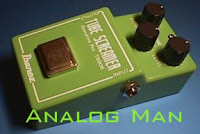
In early 2004 Ibanez finally reissued the TS-808 pedal due to popular demand. It looks fine except the color seems a bit off. The reissue TS-808 uses the new 2002+ TS9 reissue board, made by Ibanez, not the older, slightly better quality MAXON board like the original TS808 and pre-2002 TS9. It does have the correct JRC4558D op amp and output resistors, so it sounds better than the TS9 reissue, similar to our CLASSIC TS9/808 mod. We have a cool mojo mod for the TS-808 reissue and also offer our SILVER mod on it. See my tube screamer page for more info.
TS9DX Turbo
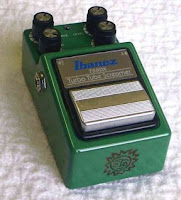
TS7 Tone Lok
The latest new tube screamer was made available about early 2000, the TS7 TONE-LOK pedal. It is made in Taiwan like the TS5 but in a metal case that should stand up better. There are several circuit boards inside, they seem to be generic and several different effects can be built using the same boards (they are mostly empty boards!). These have a HOT mode switch for extra distortion and volume, which is quite useable. The HOT mode still works after the mod, and gets a similar improvement to the tone (less harsh, smoother, but still has lots of drive). Most TS7 pedals come with the correct JRC4558D chip, so we usually don't have to change the chip in our TS7 mods. The TS7 is a lot cheaper than a TS9 but I don't think they will hold up as well to severe use. All the boards, connectors, and cables inside add a lot of complexity and there are many things to break. Also the tiny micro switches seem to be failing and we do not carry replacements.
Maxon Pedals
Maxon OD-808 mods
We have worked on the Maxon OD-808 and now offer our 808/SILVER mod for it. The Maxon OD-808 is actually a TS-10 circuit (uses TS9/TS10 output section) so it takes some serious work. The circuit boards are a little fragile, like the 2003+ TS9s, so we have to be very careful so as not to damage them. We also include TRUE BYPASS on these mods because Maxon uses a normal size stomp switch which we can easily change to a 3PDT switch for true bypass. So if you are a stickler for true bypass, the Maxon OD-808/Silver may be the pedal for you.
Maxon OD-9 mods
The Maxon OD-9 was released in the summer of 2002. It is a TS9 with the correct JRC4558D chip and originally had a DPDT switch replacing the FET switching. It has "normal" bypass like an old 70s pedal but did not really suck any tone when OFF. Later ones have a 4pdt switch for true bypass and LED switching. Since it is an exact TS9 circuit, we offer the same mods on the OD-9 as the TS9, either the CLASSIC or the SILVER mod, along with KWS option.
Tube Screamer Questions and Answers
Can you make my Tube Screamer true bypass??
In order to make an Ibanez, Boss or other electronically- switched pedal true bypass, you need to drill a hole on top and mount a standard round metal stomp switch. On the TS9 there is already a small hole under the plaque on top, and there is just enough room for a switch. You also need to hot-wire the circuit so it is always ON. I do not offer this mod as drilling and mounting the switch is very time consuming and messy. Also these pedals do not suck tone like a wah wah when off, as they use active electronic FET switching so it is not much of a benefit if any at all. The Boss pedals seem to effect your tone a bit less than the Ibanez pedals when OFF (less high end attenuation).
If you don't already have a tube screamer, and want true bypass, the Maxon OD9 is the obvious choice.
An easier solution would be to use a TRUE BYPASS box, which is a small box with IN, OUT, SEND, and RETURN jacks, and a switch. When OFF, the signal goes direct from the IN to the OUT jack. When ON, the signal goes through the SEND/RETURN effects loop (and the pedal that you have in that loop). These are handy for having around, you can even use it as an AB box in a bind. I can build these out of the MXR PAPERWEIGHTS that I have, or in generic cases. It is even possible to build multiple true bypass boxes with multiple loops/switches. They are about $85 for a normal true bypass box in a generic case. I tested a TS9 in my TRUE BYPASS BOX to see if the TS9 was effecting the tone when it was OFF. There was a small loss in very high frequencies, but the sound was excellent and actually can be better when using very bright amps like my Deluxe Reverb.
Using a Tube Screamer for CLEAN BOOST mode
Another use, which works best with a TS-808 or my TS-808 mod is a clean boost. Turn the gain (top left) knob almost all the way down (maybe on 1) and turn the tone (middle) knob down almost all the way too, and crank up the output volume (top right) to the desired boost level. This can boost a tube amp with nice smooth tone and very little pedal distortion (makes more tube distortion).
Capacitors (low end) and Drive mods
Do you change the capacitors or other components in your mod?
My CLASSIC TS-808 mod does not change the capacitor values, it uses the exact same values as an original TS-808. Anyone can find information online on changing various capacitors in a tube screamer to add low end. I have tried every mod I have seen online and many more that I came up with, and none of the simple capacitor changes sound quite right. They lose the sweet tone which is the reason to use a tube screamer, though it will sound good in a bedroom it will get very muddy on stage or recording with a band. These easy capacitor mods boost the low end like in the TS9DX modes, so it gets muddy. When we sell the DX we recommend our MODE MODS on the DX, which changes the deepest mode to about the same amount of low end as the 2nd mode on the stock DX. We also do not increase the DRIVE, as this does not sound right on a tube screamer. If you need more drive, it is better to use another pedal either seperately or along with the tube screamer. Or many people use two tube screamers in a row, Trey from Phish and Kenny Wayne Shepherd are some of our more famous customers who use them this way.
Keep on Screamin!
Images Gallery Of Tube Screamer
Credit goes to: mike aNaLoG.MaN
Original TS-808 data
The following list are some of the serial numbers and features of TS-808 pedals. (R) means the trademark after Ibanez on the top of the pedal.
- 111642 (R) JRC4558D 1980 nut on power jack
- 112198 (R) JRC4558D 1980, nut on power jack 2SK121 FETS
- 112862 (R) RC4558P Malaysia 1980/31st week, nut on power jack
- 116118 (R) RC4558P Malaysia, nut on power jack
- 120229 (R)
- 120274 (R) RC4558P 1980/35th week, power jack nut
- 120407 (R)
- 122858 (R)
- 126469 (R) RC4558P
- 126648 (R)
- 127460 (R) JRC4558D 1980 chip
- 131544 (R) RC4558P Malaysia 1980/40th week, no power jack nut
- 131542 (?) no power jack nut, 2SK44
- 131630 (R) RC4558P malaysia chip 1980/35th week, 2SK44
- 131661 (R)
- 139290 (R) no nut on power jack, JRC4558D 0727 chip made in 1980
- 139329 (R)
- 139659 no nut on jack, Texas inst Malaysia chip
- 139767 TI RC4558P
- 144650 TL4558P 1981?
- 144990 no (R)
- 146264 (R) is OD-855 in TS808 shell
- 151870 (R) (orig#?) 1981 JRC4558D
- 152048 (R)
- 153125 no (R)
- 154114 no (R) JRC4558D
- 157788 no (R)
- 158135 (R)'81 JRC4558D
- 162972 JRC4558D killer tone
- 163311 no (R) JRC4558D, 1981 chip
- 164337 no (R) JRC4558D, no power jack nut, 1981 chip and caps
- 170002 no (R) '81 JRC4558D chip, no power jack nut
- 175729 no (R) JRC4558D chip, no power jack nut
- 177390 no (R) '81 JRC4558D, no power jack nut
- 178490 no (R)
- 181298 no (R) or nut, 1981 JRC4558D 1444 2SK44 FETS
As you can see, the JRC chip was used throughout the life of the TS-808. There was even another 4558 chip, the TL4558P, used sometimes. In AB tests, there is VERY little difference between the three chips, although the JRC gives the strongest CLASSIC tube screamer sound- the sweet vocal midrange. The Malaysian RC4558P chip was probably used to save some money as they were cheaper than a Japanese made JRC chip. We would be glad to use the RC chip in your mod if you would like. They have a little bit more grit which some people might like.
SRV used the TS-808 for his trademark juicy strat tone. When he used smaller Fender amps that had natural overdrive, he used the TS set clean (low drive setting) with the level up high to push the amp for more distortion (see my CLEAN BOOST info below). When he played through big clean amps he turned the drive up more, about 1/2 way, with tone on about 3 and level about 7 to get the distortion from the TS.
TS9

Around 1982 until 1985 the Ibanez pedals were repackaged and the 9-series of effects were made. The most popular is the TS-9 tube screamer, which is almost the same as the TS-808 internally. Externally the on/off switch grew to fill about 1/3 of the effect. The main change in the TS-9 circuit is in the output section. This caused the tube screamer to be a bit brighter and less "smooth". The Edge from U2 uses a TS9 for most of his overdrive tones, as do countless other famous rock and blues players. In later years the TS-9s were put together with seemingly random op-amp chips, instead of the JRC-4558 which is called for in the schematics. Some of these sound BAD, especially the JRC 2043DD chips. If you have an original TS9 with the 2043 chip, our 808 mods will make a huge difference in tone.
STL and TS10

After the 9 series was discontinued, the MASTER or L series pedals were made, without a tube screamer in the lineup. This series was only made in about 1985. They did include the SUPER TUBE model STL, which is like a 4 knob tube screamer. It is similar to the rare and valuable ST-9 Super Tube Screamer which seems to have been sold only in Europe. Then in about 1986 the similarly made POWER SERIES or 10 series appeared, including the TS-10 tube screamer. Compared to a TS-808, a TS-10 has about 3 times more circuit changes than the TS-9 had. From about 1988 through 89 when the 10 series ended, some TS-10 pedals were made in Taiwan, using an MC4558 chip. All TS-10s (and other L and 10 series pedals) used cheap jacks and pots which were mounted to the boards instead of the cases, so they often break or fall apart. There is also a ribbon cable inside which attaches the pot board to the main board.
The plastic TS-5 "Soundtank" followed the TS-10 and was available until about 1999 when the TS7 "TONE LOK" series came out. The TS-5 circuit is very similar to the TS-9 but made in Taiwan by DAPHON with cheaper, smaller components. Also, the box is plastic so there may be more noise than a shielded metal TS-808 or TS-9 box. Some people are happy with these but most prefer the older ones.
In about 1993, Ibanez started to make the TS-9 again due to popular demand. This "reissue" is just about identical to the last "original" TS-9s in sound, circuitry, and appearance. They even used the old manual dated 1981 to confuse us more! The IC chip they use in the reissue is the same as some later original TS-9s, the Toshiba TA75558. They are a higher tech chip that will work good in higher tech equipment (where you want a low noise op amp) but are not the best for a tube screamer. If you want some of these chips I have a few hundred slightly used ones! ;-)
In about June of '96 the reissue TS-9 was changed slightly, and finally can be told from an "original" TS-9 easily. There is a "CE" symbol on the back, which is required for selling electronics in Europe. Also a capacitor was added to the back of the board (the only component ever used on the back of a tube screamer board). This is to help with the switching circuit and should not affect the sound. The extra capacitor is no longer used, now they changed the value of C113 from 102 to 103 (10,000pF). C113 is between the wires labeled 3 and 4 on the back of the board. If you have a 102 you can change it to 103 to improve switching (switching is the one thing about TS-9s that sucks!). I think the new TS-9 sounds the same as the earlier reissues and last originals.
In late 2002 the largest change to the TS9 ever took place. Maxon (actually Nisshin Onpa, the manufacturer or Maxon pedals) is no longer making the TS9 and TS9DX pedals for Ibanez. Ibanez is now having another company make them. The new TS9s are now easy to distinguish. The new circuit board is of slightly cheaper construction, and no longer says MAXON, now it says Ibanez. You will also see IBANEZ cast into the case if you pull back the foam a bit near the battery, the older ones said MAXON there. The battery covers also have IBANEZ on them instead of Maxon. The battery covers had never been changed since the original TS-808.
The input jacks on the late 2002 models were terrible and tended to jam, with the plug stuck in tight. In 2003 they made them a little better. Otherwise they are about the same as the Maxon made TS9 pedals and seem to sound the same. But the boards are more fragile, so extreme care needs to be taken when modifying them. But they should be fine, we have not had many problems with these, and the switches seem better than before.
TS9 originals VS reissues

Here are the bottoms of the four different TS9s. On the right is an original with black label, easy to tell and date, if 1st digit is a 1, that would mean 1981 (a VERY early TS9!). These usually have the JRC4558D chip, or sometimes the lousy JRC2043D chip.
Second on the right is an original silver label TS9. The 1st digit is a 3 meaning 1983, you will see a lot of these with a 4 for 1984. These can have the earlier chips or sometimes the TA75558 chip as used in the reissues. These are almost impossible to tell from the 1st reissue TS9. But the Reissue TS9 will usually not have a serial # starting with 3 or 4. I have reissues with a 206XXX and 207XXX number here with a capacitor made in 1990, maybe a very early reissue from 1992. These have silver labels, an original from 1982 would probably have had a black label. I also see a lot of TS9s with serial # starting with 1 with a silver label. These are all reissues as a 1981 would be a TS808 or a very early TS9 with a black label. However I have seen a 1983 TS9 with serial number 299866 with a silver label. It has the JRC4558D chip and capacitors with 1983 date codes and resistors coated in green. So if the first digit is 2 and the label is silver you will have to open it up to date it.
Third from the right is a 2nd version reissue, with the CE symbol so you know it's a reissue. It still uses the original MAXON circuit board and MAXON on the battery cover. The reissues all have the TA75558 chip. Note the box has bar code info, this will not be found on the original boxes.
On the left is the latest 2002+ reissue, with the IBANEZ board and IBANEZ on the battery cover.
TS-808 reissue

In early 2004 Ibanez finally reissued the TS-808 pedal due to popular demand. It looks fine except the color seems a bit off. The reissue TS-808 uses the new 2002+ TS9 reissue board, made by Ibanez, not the older, slightly better quality MAXON board like the original TS808 and pre-2002 TS9. It does have the correct JRC4558D op amp and output resistors, so it sounds better than the TS9 reissue, similar to our CLASSIC TS9/808 mod. We have a cool mojo mod for the TS-808 reissue and also offer our SILVER mod on it. See my tube screamer page for more info.
TS9DX Turbo

TS7 Tone Lok
The latest new tube screamer was made available about early 2000, the TS7 TONE-LOK pedal. It is made in Taiwan like the TS5 but in a metal case that should stand up better. There are several circuit boards inside, they seem to be generic and several different effects can be built using the same boards (they are mostly empty boards!). These have a HOT mode switch for extra distortion and volume, which is quite useable. The HOT mode still works after the mod, and gets a similar improvement to the tone (less harsh, smoother, but still has lots of drive). Most TS7 pedals come with the correct JRC4558D chip, so we usually don't have to change the chip in our TS7 mods. The TS7 is a lot cheaper than a TS9 but I don't think they will hold up as well to severe use. All the boards, connectors, and cables inside add a lot of complexity and there are many things to break. Also the tiny micro switches seem to be failing and we do not carry replacements.
Maxon Pedals
Maxon OD-808 mods
We have worked on the Maxon OD-808 and now offer our 808/SILVER mod for it. The Maxon OD-808 is actually a TS-10 circuit (uses TS9/TS10 output section) so it takes some serious work. The circuit boards are a little fragile, like the 2003+ TS9s, so we have to be very careful so as not to damage them. We also include TRUE BYPASS on these mods because Maxon uses a normal size stomp switch which we can easily change to a 3PDT switch for true bypass. So if you are a stickler for true bypass, the Maxon OD-808/Silver may be the pedal for you.
Maxon OD-9 mods
The Maxon OD-9 was released in the summer of 2002. It is a TS9 with the correct JRC4558D chip and originally had a DPDT switch replacing the FET switching. It has "normal" bypass like an old 70s pedal but did not really suck any tone when OFF. Later ones have a 4pdt switch for true bypass and LED switching. Since it is an exact TS9 circuit, we offer the same mods on the OD-9 as the TS9, either the CLASSIC or the SILVER mod, along with KWS option.
Tube Screamer Questions and Answers
Can you make my Tube Screamer true bypass??
In order to make an Ibanez, Boss or other electronically- switched pedal true bypass, you need to drill a hole on top and mount a standard round metal stomp switch. On the TS9 there is already a small hole under the plaque on top, and there is just enough room for a switch. You also need to hot-wire the circuit so it is always ON. I do not offer this mod as drilling and mounting the switch is very time consuming and messy. Also these pedals do not suck tone like a wah wah when off, as they use active electronic FET switching so it is not much of a benefit if any at all. The Boss pedals seem to effect your tone a bit less than the Ibanez pedals when OFF (less high end attenuation).
If you don't already have a tube screamer, and want true bypass, the Maxon OD9 is the obvious choice.
An easier solution would be to use a TRUE BYPASS box, which is a small box with IN, OUT, SEND, and RETURN jacks, and a switch. When OFF, the signal goes direct from the IN to the OUT jack. When ON, the signal goes through the SEND/RETURN effects loop (and the pedal that you have in that loop). These are handy for having around, you can even use it as an AB box in a bind. I can build these out of the MXR PAPERWEIGHTS that I have, or in generic cases. It is even possible to build multiple true bypass boxes with multiple loops/switches. They are about $85 for a normal true bypass box in a generic case. I tested a TS9 in my TRUE BYPASS BOX to see if the TS9 was effecting the tone when it was OFF. There was a small loss in very high frequencies, but the sound was excellent and actually can be better when using very bright amps like my Deluxe Reverb.
Using a Tube Screamer for CLEAN BOOST mode
Another use, which works best with a TS-808 or my TS-808 mod is a clean boost. Turn the gain (top left) knob almost all the way down (maybe on 1) and turn the tone (middle) knob down almost all the way too, and crank up the output volume (top right) to the desired boost level. This can boost a tube amp with nice smooth tone and very little pedal distortion (makes more tube distortion).
Capacitors (low end) and Drive mods
Do you change the capacitors or other components in your mod?
My CLASSIC TS-808 mod does not change the capacitor values, it uses the exact same values as an original TS-808. Anyone can find information online on changing various capacitors in a tube screamer to add low end. I have tried every mod I have seen online and many more that I came up with, and none of the simple capacitor changes sound quite right. They lose the sweet tone which is the reason to use a tube screamer, though it will sound good in a bedroom it will get very muddy on stage or recording with a band. These easy capacitor mods boost the low end like in the TS9DX modes, so it gets muddy. When we sell the DX we recommend our MODE MODS on the DX, which changes the deepest mode to about the same amount of low end as the 2nd mode on the stock DX. We also do not increase the DRIVE, as this does not sound right on a tube screamer. If you need more drive, it is better to use another pedal either seperately or along with the tube screamer. Or many people use two tube screamers in a row, Trey from Phish and Kenny Wayne Shepherd are some of our more famous customers who use them this way.
Keep on Screamin!
Images Gallery Of Tube Screamer
Credit goes to: mike aNaLoG.MaN

No comments:
Post a Comment